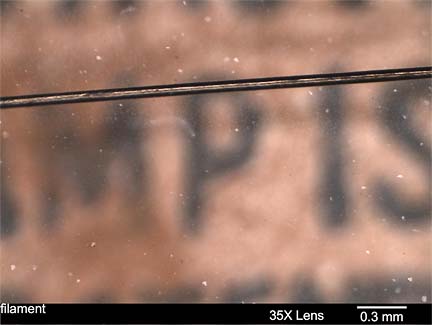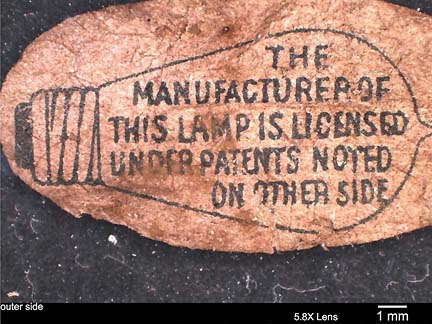
LIVERMORE, CA
Bernice E. Mills
Jeff M. Chames
Howard A. Johnsen
The following test results were conducted at the Sandia
National Laboratories, Livermore, CA facility under the supervision
of Bernice E. Mills. The primary question being what material
was this filament composed of to make it conducive to such a
prolonged life. She was given a 30W Shelby Bulb, from the Shelby
Lamp Works in the early 1900s, to our knowledge the same company,
vintage, and make as those of the 60W Centennial Light Bulb.
Optical image of filament with 35x lens
 |
Patent Paper
 |
 |
|
Optical image of paper folded and sealed in glass
inside lamp. Top image was the only one visible without breaking
glass. |
|
Secondary electron images of filament at 52x, 200x, 500x,
2000x. Analysis by x-ray spectroscopy, which samples microns
deep, indicates the filament is carbon. Some of the white flecks
are silica, presumably from the glass. |
Lamp at two orthagonal orientaions in x-ray microscope.
X-ray source to left, camera to right
|
X-ray of old bulb at left compared with new bulb
at right shows that the filament cannot be seen through the glass
and therefor must be of low atomic number.
|
The pin to which the filament is attached is easily
seen through the glass. The attachment material is not seen.
|
The loops of the filament are seen in an x-ray image.
A close-up allows us to measure the diameter of the filament.
The white edge that is seen in the image is the phase contrast.
|
A section of the fiament is seen in this three dimensional
x-ray image.
|
The filament is distincly round as seen in these
three dimensional x-ray images of a section of filament. The
lower image highlights the surface texture of the filament.
|
Auger spectroscopy, which only samples nanometers
of the surface, shows the filament to be carbon. This precludes
the filament having been plated with some metal.
|
Credits
|
Howard A. Johnsen mounted the lamp for further
work.
Jeff M. Chames broke the outer and inner glass
envelope and produced optical and secondary electron images of
the filament and the paper with the patent numbers. He also took
x-ray spectra to demonstrate that the filament was made of the
carbon with small flecks of silica on the surface.
Dr. Bernice E. Mills performed the x-ray computed
tomography both before and after the outer glass was removed
to show that the filament could not be seen through the glass
envelope and to show that the filament is round with a diameter
of about 80 microns or 3 mils and with small bits of debris on
the surface. She also analyzed the surface of the filament with
Auger spectroscopy to confirm that even the surface is carbon
and cannot have been plated. |
Thank You
|
Thank you Dr. Bernice E. Mills for your time, as
well as Howard A. Johnsen, and Jeff M. Chames for your efforts
in finding some long sought answers to the Centennial Bulb.
If you would prefer to see this report in the original
PDF format please follow this link, Sandia Test Results. |
Sandia National Laboratories is a multi-program laboratory
managed and operated by Sandia Corporation, a wholly owned subsidiary
of Lockheed Martin Corporation, for the U.S. Department of Energy’s
National Nuclear Security Administration under contract DE-AC04-94AL85000.
|
|